The first page opened with the poem, "Always Growing," followed by a continuation of the "Home Difficulties of a Young Girl" first offered in the Volume 3, Number 6 issue. In this episode, "Fanny" the returned Carlisle protagonist set out to put things right, finally recovering from her despair at first finding her childhood home in such a mess…
Dickinson College Archives & Special Collections
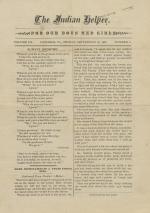
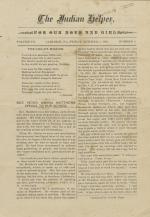
Page one opened with the poem, "The Child's Mission," followed by a report called "Rev. Peter Owaha Matthews Speaks to Our School," which was continued on the fourth page. It was the account of an assimilated Indian and the trials he overcame to become a successful, educated professional. Page two contained news of the literary and…
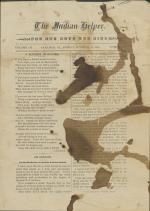
The first page began with the poem, "Sermon in Rhyme," followed by Carlos Montezuma's "An Apache" in which he wrote from the Chicago Medical College telling his story of being kidnapped and raised in the white world. His account continued on page four. Page two included the account of the death of student Bruce Hayman (Pawnee) who died visiting…
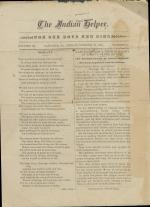
The first page began with the poem, "Nobility," by Alice Cary followed by "A Letter from a Dear Old Lady of Eighty Years of Age," who shared her childhood recollections of life among the Tuscarora Indians camped on her family's land in Canada, some of whom became her playmates. This letter was continued on the fourth page. The second page…
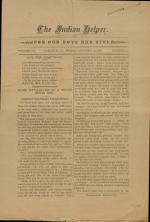
This issue began with the poem, "Live for Something," followed by the continuation of the series begun in Number 8 entitled "Home Difficulties of a Young Indian Girl," about Fanny, a Carlisle alumnus struggling to apply her new-found skills to home life. The second page featured news items including a report from the Hampton School in…
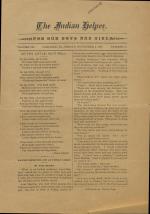
The first page opened with the poem, "Do Thy Little; Do it Well," followed by a story by Aunt Martha called "Pawnee Medicine and an Indian Lodge," about Pawnee dances and medicine men. The second page featured news about the steam printer, the return of Miss Ely, an open air concert by the band, the Indian Union Debating Club, and a…
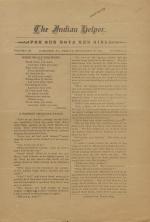
The first page featured a poem "Work While You Work" followed by "A Pawnee Medicine-Dance" which continued the story from number 14 told by Aunt Martha about Pawnee medicine men and their dances. The second page had news of returned students whose terms at Carlisle were completed, including Minnie Swallow Bear, Annie Menaul, and Thomas Rester.…
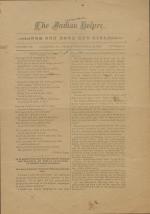
The first page opened with the poem, "Work and Play," followed by a reprint of Dennison Wheelock's first prize essay entitled, "Is It Right for the Government to Stop the Teaching of Indian Languages in Reservation Schools," arguing for the affirmative. The second page featured news about students who returned home after completing their terms…
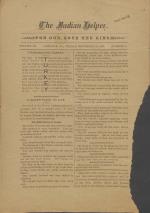
The first page opened with a poem, "Thanksgiving Turkey," a play on the letters in the word "Turkey" followed by a description of the Acoma Pueblo by student Annie Thomas, entitled "A Queer Place To Live." This also was a subject of the article written about the monthly exhibition on page 3. The second page included news of students who…
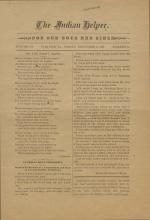
The first page opened with a poem, "Do the Right, Boys," followed by a letter from Richard Yellow Robe, entitled "An Indian Boy's Experience: Written by Himself as a Composition and Read at our last Month's Exhibition" about his escape from the battle in which Custer was killed and his subsequent enrollment in the Carlisle Indian School.…
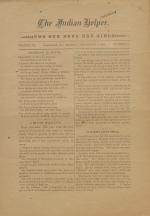
The first page opened with a short poem, "Grammar In Rhyme," followed by the memoir of Sioux student, Hope Red Bear about the Battle of the Big Horn, entitled "A Bit of Wild Life." There was also a piece about the treatment of horses called "If Horses Could Speak." The second page featured news of the passing of former student Dan Tucker'…
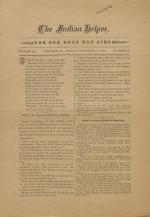
The first page opened with an untitled poem about kindness, followed by "Part of Our Hospital Work," a reprint of a composition by Nancy Cornelius (Oneida) who detailed her experiences as a hospital assistant. She wrote about the breakfast routine and the Apache mothers caring for their babies at the hospital. There was also an article…
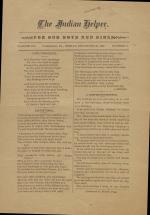
The first page opened with a two poems, "Christmas Eve," and "Christmas," about the true meaning of Christmas. Next came a story about a monkey who developed an intolerance to whiskey, entitled "A Temperance Monkey," which was continued on the fourth page. Page two opened with a report about the monthly exhibition followed by news that the boys…
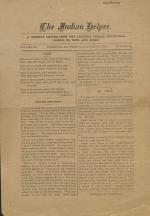
The first page opened with a poem, "Dare," followed by a story, "Engines and Boys," that reported the arrival by train of the new fire engine called "Uncle Sam." Then came a piece entitled, "Be Neat," on the importance of being neat and orderly. It continued on page four. Page two reported the experience of the four girls who visited the White…
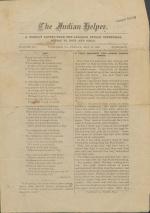
The first page opened with a poem, "Try," followed by a blurb against tobacco use and by "A Visit Through the Lower School Rooms," that reported the activities of students in the lower grades. It continued on page four. The second page bore news of students out in the country, the "disgraceful" portrayals of Indians by Buffalo Bill's Wild West…
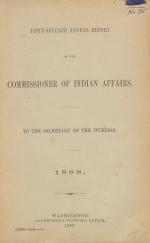
An excerpt from the Annual Report of the Commissioner of Indian Affairs to the Secretary of the Interior for the fiscal year ending 1888, containing the Ninth Annual Report of the Carlisle Indian Industrial School. The report, submitted by Superintendent Richard Henry Pratt, includes a school population table as well as discussions of industry…
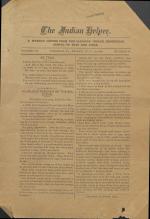
The first page opened with the poem “Be True” followed by an article titled “A Carlisle Teacher on the Big Ocean,” about a trip aboard the Steamer Aurania dated July 6th, 1888 written for the Man-on-the-band-stand by “A Carlisle,” aka Miss Lowe. The article concluded on the fourth page. Page two featured a variety of small newsy paragraphs that…
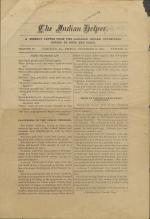
The first page opened with a poem titled “How To Make Up,” followed by an article reprinted from The Sabbath School Visitor titled “Playthings of the Indian Children.” Next came a letter from Nancy Cornelius (Oneida) titled “Items of Interest From Nancy Cornelius,” which was sent from the Training School for Nurses at Hartford, Connecticut and…
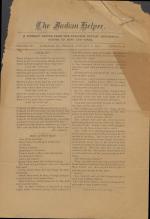
The first page opened with a poem titled “Look Up!” followed by a report that described, “Our Christmas?” and detailed the holiday events celebrated at the Indian School that included Santa Claus’ visit, who filled students’ hats and stockings with fruit, nuts and candy, and concluded with a description of a turkey dinner. Page two opened with…
A description of this article is not currently available.
Frances E. Willard, "The Carlisle Indian School," The Chautauquan 9, no. 5 (February 1889): 289-290.
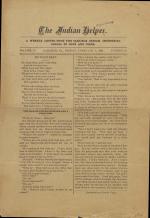
The first page began with a poem titled “Do Your Best,” followed by “The Man-On-the-Band-Stand and a Stranger,” which described the “old gentleman’s” effort to thwart the hiring of an Outing student who was careless with arithmetic. It continued on page four. Page two began with “A Manly Resolution,” that reported Felix Iron Eaglefeather’s (…
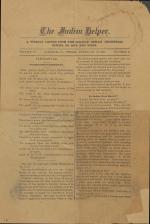
The first page began with the heading, “February 22,” followed by poems and articles about George Washington and his birthday. Also on the page was a piece called “Do Indian Boys Have It?” about the pitfalls of self-conceit. Page two included many small articles that included an update of area postal routes, a description of Eugene Tahkapeur’s…
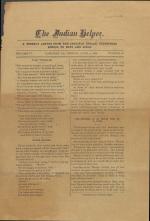
The first page began with a poem titled, “The Tongue,” followed by the Man-on-the-band-stand’s discussion in “Never Before,” that explained that a horde of boys would be marching east toward opportunity but a horde of boys would be marching west toward degradation, which he described as “evil practices and rot.” The page continued with “The…
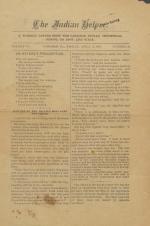
The first page began with a poem titled, “Dr. Nature’s Prescription,” followed by “How One of the Printer Boys Came Out Ahead,” which described how a printer, against the advice of his instructor, was able to repair faulty equipment using his own problem solving technique. This was followed by a short blurb warning against smoking. Page two…
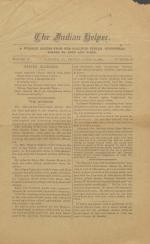
The first page began with a poem titled, “Easter Blossoms,” followed by a notice of “The Wedding” between Guy LeRoy Stevick and Marion Pratt, the daughter of Capt. Pratt. The ceremony was performed by Rev. Dr. Norcross of Second Presbyterian Church followed by a reception for 500 guests in the Indian School gymnasium. Also included on the page…
